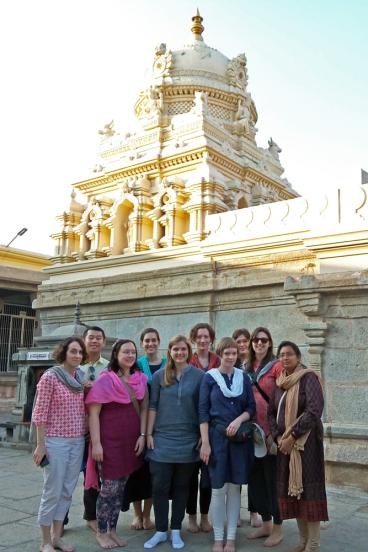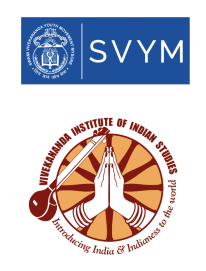Lessons from India: Experiential learning outside and inside the classroom
Liz Sopdie, far left, stands with her classmates at the Mysore Palace before a tour
The most valuable lessons Liz Sopdie, PhD, learned during her three-week course in Mysore, India were those she learned outside the classroom.
“Going somewhere new to learn can be life changing,” she said. “Travel promotes personal growth and teaches you about your own resilience. The entire experience is something you can’t get in a classroom or in a familiar place.”
In 2018, Sopdie joined eight strangers on a 30-hour journey to the second most populous country in the world as part of the India: Global Health, Globalization and Leadership course. They spent mornings learning from different experts, covering topics such as private versus public healthcare systems in India. The rest of the day was dedicated to getting hands-on experience in the field and soaking in Mysore culture.
After a pandemic hiatus, the Center for Global Health and Social Responsibility (CGHSR) course is back on for winter break 2022–2023.
“I learned so much more information than I ever thought I would and it had a huge impact on how I thought about my doctoral research and what I wanted to do after,” said Sopdie, who now works with rural and urban underserved populations in Minnesota through the U of M’s Rural Physician Associate Program (RPAP).

Many of the challenges to social determinants of health she learned about in Mysore were similar in the U.S. and India, but there are some unique factors, she said. For one, 65 percent of India’s population lives in rural areas, compared to 17 percent of people in the U.S, according to World Bank data.
“The big rural population affects the way public policy is designed and implemented,” said Sopdie, adding that in addition, health issues in India are exacerbated by climate change in a way many Americans are still shielded from.
“Things that we might not think twice about are everyday challenges for people living in other places –– pollution, air quality, access to clean water, infrastructure that supports things like sewers and toilets,” she said. “I was really interested in one lecture on water and sanitation – it really highlighted the structures and how things are addressed at a broader policy level in India.”
In the rural areas of Mysore, healthcare is largely carried out by community-tailored initiatives. Accredited social health activists (ASHA) –– community health workers who are employed by India’s Ministry of Health and Family Welfare (MoHFW) as a part of the National Rural Health Mission (NRHM) –– help people seek healthcare, get to appointments, advocate for patients and accompany pregnant women to hospitals when it’s time to give birth, and return home with them and the new baby to help them get settled.
But Mysore is also home to a metropolitan health care system that functions in a way that better suits the needs of citydwellers.
“The sheer size of the population raises a lot of challenges but also a lot of different solutions,” said Sopdie. “There have to be so many multi-pronged approaches to looking at social determinants of health and health care solutions because they can be so vastly different in the same region. India really has some strengths we can learn from and apply to the U.S.”

Local Expertise and Mutual Partnership
The course from CGHSR is co-designed and taught locally by the Swami Vivekananda Youth Movement (SVYM) and Vivekananda Institute of Indian Studies (VIIS), non-profit organizations located in Mysore. The organizations have worked in the fields of health, public health, advocacy, and education in southern India for more than three decades and have been advising the state and central government in India on public policy issues.
Collaborating directly with SVYM and VIIS is vital to CGHSR’s mission of mutual partnership and bi-directional work. The course is taught entirely by community instructors in Mysore, which ensures that the learning imparted in the course is locally owned, led, and relevant.
Applications for this year’s course will open on August 15, 2022 and the course will run from December 29 to January 14, 2023. In addition to UMN graduate students, this year the course is open to faculty and alumni.
“This was a fantastic experience—if anyone is thinking about taking the course, go for it,” enthused Sopdie. “I was nervous to spend 3 weeks in another country in a classroom full of people I didn’t know, but the nine of us quickly bonded through traveling.”
Questions about the course can be directed to CGHSR at [email protected], and more information is available at globalhealthcenter.umn.edu/india
